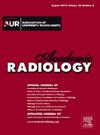Development and Validation of a Biparametric MRI Deep Learning Radiomics Model with Clinical Characteristics for Predicting Perineural Invasion in Patients with Prostate Cancer
IF 3.9
2区 医学
Q1 RADIOLOGY, NUCLEAR MEDICINE & MEDICAL IMAGING
引用次数: 0
Abstract
Rationale and Objectives
Perineural invasion (PNI) is an important prognostic biomarker for prostate cancer (PCa). This study aimed to develop and validate a predictive model integrating biparametric MRI-based deep learning radiomics and clinical characteristics for the non-invasive prediction of PNI in patients with PCa.
Materials and Methods
In this prospective study, 557 PCa patients who underwent preoperative MRI and radical prostatectomy were recruited and randomly divided into the training and the validation cohorts at a ratio of 7:3. Clinical model for predicting PNI was constructed by univariate and multivariate regression analyses on various clinical indicators, followed by logistic regression. Radiomics and deep learning methods were used to develop different MRI-based radiomics and deep learning models. Subsequently, the clinical, radiomics, and deep learning signatures were combined to develop the integrated deep learning-radiomics-clinical model (DLRC). The performance of the models was assessed by plotting the receiver operating characteristic (ROC) curves and precision–recall (PR) curves, as well as calculating the area under the ROC and PR curves (ROC-AUC and PR-AUC). The calibration curve and decision curve were used to evaluate the model’s goodness of fit and clinical benefit.
Results
The DLRC model demonstrated the highest performance in both the training and the validation cohorts, with ROC-AUCs of 0.914 and 0.848, respectively, and PR-AUCs of 0.948 and 0.926, respectively. The DLRC model showed good calibration and clinical benefit in both cohorts.
Conclusion
The DLRC model, which integrated clinical, radiomics, and deep learning signatures, can serve as a robust tool for predicting PNI in patients with PCa, thus aiding in developing effective treatment strategies.
开发和验证具有临床特征的双参数磁共振成像深度学习放射组学模型,用于预测前列腺癌患者的神经周围侵犯。
理由和目的:硬膜外侵犯(PNI)是前列腺癌(PCa)的重要预后生物标志物。本研究旨在开发和验证一种预测模型,该模型整合了基于双参数 MRI 的深度学习放射组学和临床特征,用于无创预测 PCa 患者的 PNI:在这项前瞻性研究中,招募了557名接受术前MRI检查和根治性前列腺切除术的PCa患者,并按7:3的比例随机分为训练组和验证组。通过对各种临床指标进行单变量和多变量回归分析,然后进行逻辑回归,构建了预测 PNI 的临床模型。放射组学和深度学习方法用于开发不同的基于 MRI 的放射组学和深度学习模型。随后,将临床、放射组学和深度学习特征结合起来,开发出深度学习-放射组学-临床综合模型(DLRC)。通过绘制接收者操作特征曲线(ROC)和精确度-召回曲线(PR),以及计算 ROC 和 PR 曲线下的面积(ROC-AUC 和 PR-AUC)来评估模型的性能。校准曲线和决策曲线用于评估模型的拟合度和临床效益:DLRC 模型在训练组和验证组中表现出最高的性能,ROC-AUC 分别为 0.914 和 0.848,PR-AUC 分别为 0.948 和 0.926。DLRC模型在两个队列中均显示出良好的校准性和临床效益:DLRC模型整合了临床、放射组学和深度学习特征,可以作为预测PCa患者PNI的可靠工具,从而帮助制定有效的治疗策略。
本文章由计算机程序翻译,如有差异,请以英文原文为准。
求助全文
约1分钟内获得全文
求助全文
来源期刊

Academic Radiology
医学-核医学
CiteScore
7.60
自引率
10.40%
发文量
432
审稿时长
18 days
期刊介绍:
Academic Radiology publishes original reports of clinical and laboratory investigations in diagnostic imaging, the diagnostic use of radioactive isotopes, computed tomography, positron emission tomography, magnetic resonance imaging, ultrasound, digital subtraction angiography, image-guided interventions and related techniques. It also includes brief technical reports describing original observations, techniques, and instrumental developments; state-of-the-art reports on clinical issues, new technology and other topics of current medical importance; meta-analyses; scientific studies and opinions on radiologic education; and letters to the Editor.
 求助内容:
求助内容: 应助结果提醒方式:
应助结果提醒方式:


